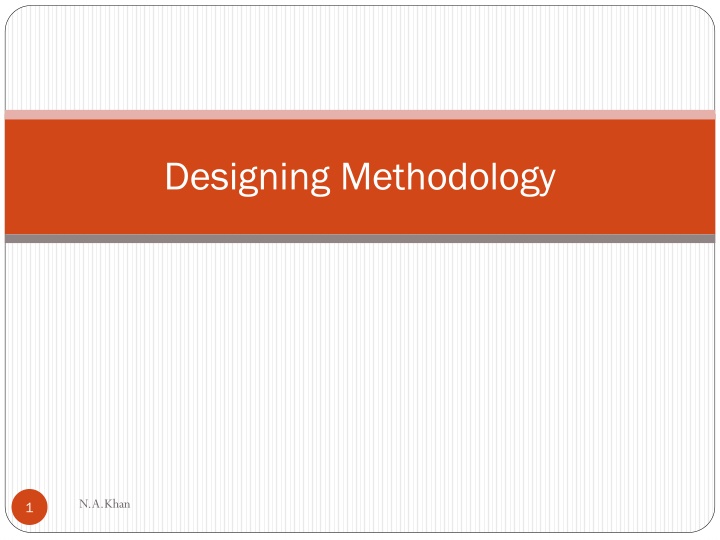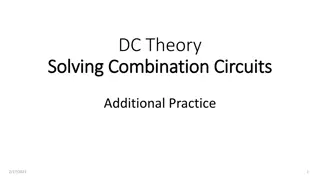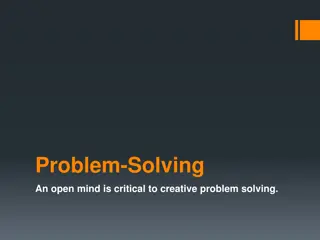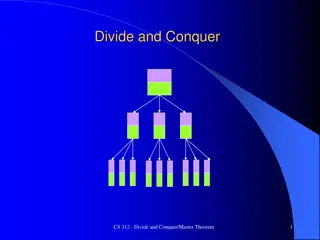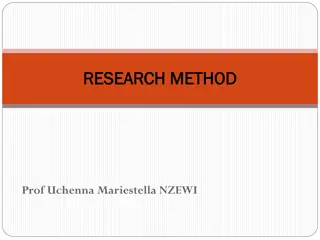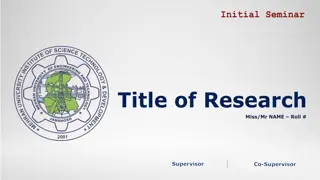Research Methodology: The Science of Systematic Problem Solving
Research methodology is essential for researchers to develop a systematic approach to solving research problems. It involves understanding various research methods and techniques to make informed decisions. Through research methodology, researchers can evaluate the relevance of different methods and techniques for their specific problems. The scope of research methodology extends beyond just methods, focusing on the logic behind choosing certain techniques and explaining why they are preferred over others for robust research outcomes.
Uploaded on Mar 01, 2025 | 5 Views
Download Presentation

Please find below an Image/Link to download the presentation.
The content on the website is provided AS IS for your information and personal use only. It may not be sold, licensed, or shared on other websites without obtaining consent from the author.If you encounter any issues during the download, it is possible that the publisher has removed the file from their server.
You are allowed to download the files provided on this website for personal or commercial use, subject to the condition that they are used lawfully. All files are the property of their respective owners.
The content on the website is provided AS IS for your information and personal use only. It may not be sold, licensed, or shared on other websites without obtaining consent from the author.
E N D
Presentation Transcript
Designing Methodology N.A.Khan 1
Introduction Research is the fountain of knowledge for the sake of knowledge and an important source of providing guidelines for solving different business, governmental and social problems. It is a sort of formal training which enables one to understand the new developments in one s field in a better way. N.A.Khan 2
Cont.. Research methods may be understood as all those methods/techniques that are used for conduction of research. All those methods which are used by the researcher during the course of studying his research problem are termed as research methods. N.A.Khan 3
Cont.. Research methodology is a way to systematically solve the research problem. It may be understood as a science of studying how research is done scientifically. N.A.Khan 4
Cont.. It is necessary for the researcher to know not only the research methods/techniques but also the methodology. Researchers not only need to know how to develop certain indices or tests, how to calculate the mean, the mode, the median or the standard deviation or chi-square, how to apply particular research techniques, but they also need to know which of these methods or techniques, are relevant and which are not, and what would they mean and indicate and why N.A.Khan 5
Cont.. All this means that it is necessary for the researcher to design his methodology for his problem as the same may differ from problem to problem. In research the scientist has to expose the research decisions to evaluation before they are implemented. He has to specify very clearly and precisely what decisions he selects and why he selects them so that they can be evaluated by others also. N.A.Khan 6
Methodology The scope of research methodology is wider than that of research methods. Thus, when we talk of research methodology we not only talk of the research methods but also consider the logic behind the methods we use in the context of our research study and explain why we are using a particular method or technique and why we are not using others so that research results are capable of being evaluated either by the researcher himself or by others. N.A.Khan 7
Why?? Why a research study has been undertaken, How the research problem has been defined, in what way and why the hypothesis has been formulated. What data have been collected and what particular method has been adopted, why particular technique of analyzing data has been used and a host of similar other questions N.A.Khan 8
Research and Scientific Method Research, as we have already stated, can be termed as an inquiry into the nature of, the reasons for, and the consequences of any particular set of circumstances, whether these circumstances are experimentally controlled or recorded just as they occur. N.A.Khan 9
Scientific Method The unity of all sciences consists alone in its methods, not its material; the man who classifies facts of any kind whatever, Who sees their mutual relation and describes their sequences, is applying the Scientific method and is a man of science. N.A.Khan 10
Research process/Methodology The following order concerning various steps provides a useful procedural guideline regarding the research process: (1) formulating the research problem; (2) extensive literature survey; (3) developing the hypothesis; (4) preparing the research design; (5) determining sample design; N.A.Khan 11
Cont.. (6) collecting the data; (7) execution of the project; (8) analysis of data; (9) hypothesis testing; (10) generalizations and interpretation, and (11) preparation of the report or presentation of the results, i.e., formal write-up of conclusions reached. N.A.Khan 12
Research methodology/Process in details N.A.Khan 13
Formulating the research problem Formulating the research problem There are two types of research problems, viz., those which relate to states of nature and those which relate to relationships between variables. Initially the problem may be stated in a broad general way and then the ambiguities, if any, relating to the problem be resolved N.A.Khan 14
Cont.. The formulation of a general topic into a specific research problem, thus, constitutes the first step in a scientific enquiry. Essentially two steps are involved in formulating the research problem, viz., understanding the problem thoroughly, and rephrasing the same into meaningful terms from an analytical point of view. N.A.Khan 15
Extensive literature survey Once the problem is formulated, a brief summary of it should be written down. It is compulsory for a research worker. For this purpose, the abstracting and indexing journals and published or unpublished bibliographies are the first place to go to. Academic journals, conference proceedings, government reports, books etc., must be tapped depending on the nature of the problem. N.A.Khan 16
Cont.. Good library will be a great help to the researcher at this stage. N.A.Khan 17
Development of working hypotheses After extensive literature survey, researcher should state in clear terms the working hypothesis or hypotheses. Working hypothesis is tentative assumption made in order to draw out and test its logical or empirical consequences. In most types of research, the development of working hypothesis plays an important role. N.A.Khan 18
Cont.. Hypothesis should be very specific and limited to the piece of research in hand because it has to be tested. The role of the hypothesis is to guide the researcher by delimiting the area of research and to keep him on the right track. N.A.Khan 19
How to develop a Hypothesis a. Discussions with colleagues and experts about the problem, its origin and the objectives in seeking a solution; b. Examination of data and records, if available, concerning the problem for possible trends, peculiarities and other clues; N.A.Khan 20
Cont.. c. Review of similar studies in the area or of the studies on similar problems; and d. Exploratory personal investigation which involves original field interviews on a limited scale with interested parties and individuals with a view to secure greater insight into the practical aspects of the problem. N.A.Khan 21
Preparing the research design The research problem having been formulated in clear cut terms, the researcher will be required to prepare a research design. Research purposes may be grouped into four categories, viz., (i) Exploration, (ii) Description, (iii) Diagnosis, and (iv) Experimentation. N.A.Khan 22
Cont.. The preparation of the research design, appropriate for a particular research problem, involves usually the consideration of the following: (i) the means of obtaining the information; (ii) the availability and skills of the researcher and his staff (if any); N.A.Khan 23
Cont.. (iii) explanation of the way in which selected means of obtaining information will be organized and the reasoning leading to the selection; (iv) the time available for research; and (v) the cost factor relating to research, i.e., the finance available for the purpose. N.A.Khan 24
Ethics Ethical considerations are important in the experimental researches. In animal studies ethical committee approval with the animal house number is important for the research. For human subjects ethical committee approval should be availed before conducting the research. N.A.Khan 25
Determining sample design The researcher must decide the way of selecting a sample or what is popularly known as the sample design. In other words, a sample design is a definite plan determined before any data are actually collected for obtaining a sample from a given population. N.A.Khan 26
Cont Samples can be either probability samples or non- probability samples. With probability samples each element has a known probability of being included in the sample but the non- probability samples do not allow the researcher to determine this probability N.A.Khan 27
Cont.. Probability samples are those based on I. simple random sampling, II. systematic sampling, III. stratified sampling, IV. cluster/area sampling N.A.Khan 28
Cont.. Whereas non-probability samples are those based on I. Convenience sampling, II. Judgment sampling and III. Quota sampling techniques N.A.Khan 29
Collecting the data Primary data can be collected either through experiment or through survey. If the researcher conducts an experiment, he observes some quantitative measurements, or the data, with the help of which he examines the truth contained in his hypothesis. N.A.Khan 30
Cont.. Designing a data collection form and defining some parameters for the experimental or observational data collection is most important. The researcher should develop his/her skills in preparing the data collection sheet/form. N.A.Khan 31
Execution of the project Execution of the project Execution of the project is a very important step in the research process. The researcher should see that the project is executed in a systematic manner and in time. Training to the research people involved in the research for data collection, entry and analysis N.A.Khan 32
Analysis of data Analysis of data After the data have been collected, the researcher turns to the task of analyzing them. Thus, researcher should classify the raw data into some purposeful and usable categories. Coding operation is usually done at this stage through which the categories of data are transformed into symbols that may be tabulated and counted. N.A.Khan 33
Cont.. Tabulation is a part of the technical procedure wherein the classified data are put in the form of tables. The mechanical devices can be made use of at this juncture. In the process of analysis, relationships or differences supporting or conflicting with original or new hypotheses should be subjected to tests of significance to determine with what validity data can be said to indicate any conclusion(s). N.A.Khan 34
Cont.. The technique of analysis of variance can help us in analyzing whether three or more varieties of seeds grown on certain fields yield significantly different results or not. In brief, the researcher can analyze the collected data with the help of various statistical measures. N.A.Khan 35
Hypothesis-testing After analyzing the data as stated above, the researcher is in a position to test the hypotheses, if any, he had formulated earlier. Do the facts support the hypotheses or they happen to be contrary? This is the usual question which should be answered while testing hypotheses. Various tests, such as Chi square test, t- test, F-test, have been developed by statisticians for the purpose. N.A.Khan 36
Generalizations and interpretation Generalizations and interpretation If a hypothesis is tested and upheld several times, it may be possible for the researcher to arrive at generalization, i.e., to build a theory. N.A.Khan 37
Preparation of the report or the thesis Preparation of the report or the thesis Finally, the researcher has to prepare the report of what has been done by him. Writing of report must be done with great care keeping in view the following: The layout of the report should be as follows; N.A.Khan 38
Cont Title of the research and Participants Introduction Aims and objectives Literature review Methods Results Discussion Conclusion Recommendation References Appendix,etc N.A.Khan 39
Criteria of Good Research 1. The purpose of the research should be clearly defined and common concepts be used. 2. The research procedure used should be described in sufficient detail. 3. The procedural design of the research should be carefully planned to yield results that are as objective as possible. 4. The researcher should report with complete frankness, flaws in procedural design and estimate their effects upon the findings. N.A.Khan 40
Cont 5. The analysis of data should be sufficiently adequate to reveal its significance and the methods of analysis used should be appropriate. 6. Conclusions should be confined to those justified by the data of the research and limited to those for which the data provide an adequate basis. 7. Greater confidence in research is warranted if the researcher is experienced, has a good reputation in research and is a person of integrity. N.A.Khan 41
Conclusion Designing research methodology is the important task in the research. Extensive literature survey will guide the researcher with knowledge and skills in the research Preparation of final report needs scientific writing skills for the researcher. N.A.Khan 42
Reference Research C.R.Kothari-Second edition. methodology-methods and techniques-by N.A.Khan 43
